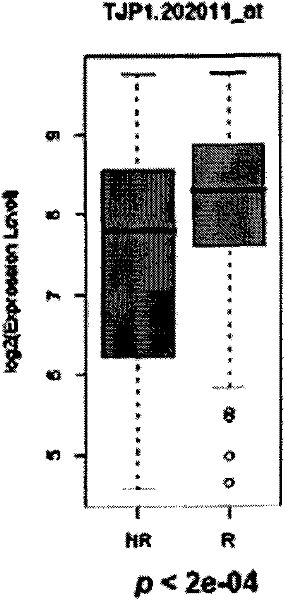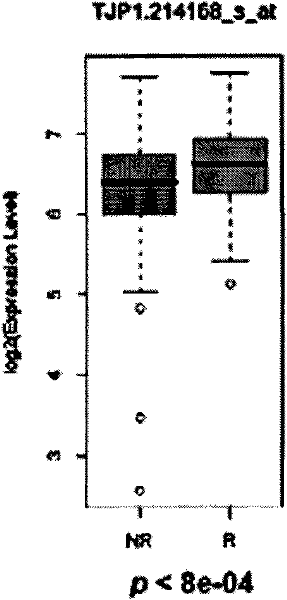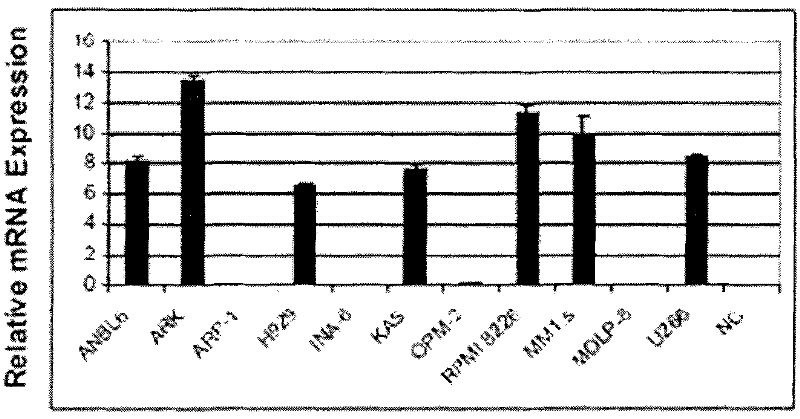Tumour chemotherapy drug sensitive gene and application of same
A chemotherapeutic drug and gene technology, applied in the direction of antineoplastic drugs, plant gene improvement, application, etc., can solve the problem of TJP1 expression loss and other problems, achieve the effect of reducing toxic and side effects, increasing the cure rate, and reducing the number of times of chemotherapy
- Summary
- Abstract
- Description
- Claims
- Application Information
AI Technical Summary
Problems solved by technology
Method used
Image
Examples
Embodiment 1
[0032] Correlation analysis between the expression of TJP1 gene and the effect of chemotherapy in tumor patients.
[0033]Through the high-throughput and large-scale RNA interference library screening work we established, we screened TJP1 as a potential chemotherapeutic drug-sensitive gene. If TJP1 determines the sensitivity of tumor patients to chemotherapy drugs, then patients with positive expression of TJP1 should respond to chemotherapy drugs, otherwise they will be insensitive to chemotherapy drugs. To this end, we performed gene map expression analysis to determine whether TJP1 gene expression was significantly correlated with patient outcomes. The gene expression database we use comes from the Multiple Myeloma Genomics Portal in the United States (http: / / www.broad.mit.edu / mmgp / pages / publicPortalHome.jsf), in which the Millennium database contains 264 cases of myeloma patients who passed Velcade or local Gene expression microarray data after dexamethasone treatment, an...
Embodiment 2
[0035] To quantitatively determine the expression of TJP1 gene in tumor cells.
[0036] Quantitative PCR was used to determine the expression level of TJP1 in tumor cells. Total RNA was prepared from tumor cells using the QIAGEN RNeasy kit (catalogue number 74104), and the preparation steps were strictly followed the product instructions. Wherein, the homogenization of tissues and cells is carried out using QIAshredder of QIAGEN (catalogue number 79654).
[0037] The concentration and quality of the prepared RNA were determined by spectrophotometry, and 1 μg of RNA was used for eDNA synthesis. The cDNA synthesis kit was carried out using Invitrogen's SuperScript III First-Strand Synthesis Super Mix (catalogue number 18080-400), and the synthesis steps were strictly followed the product instructions.
[0038] When performing quantitative PCR reaction, dilute the synthesized cDNA 5 times with nuclease-free deionized water, take 1 μl of diluted cDNA in 0.2ml In the Optical re...
Embodiment 3
[0041] The expression of TJP1 gene was significantly correlated with the semi-lethal dose (IC50) of chemotherapeutic drugs in tumor cells.
[0042] We compared the IC50 of representative MOLP-8 (no TJP1 expression) and MM1.s (high TJP1 expression) cell lines. The specific steps of the experiment were: WST-1 (purchased from Roche Diagnostics) was used to determine the IC50 data were obtained from the effects of mycin and cisplatin on cell proliferation. Cells were seeded in a 96-well culture plate at a density of 2x104 / well, and were exposed to different concentrations of doxorubicin and cisplatin after 24 hours, and the control cells were treated with a drug-free solvent. After 48 hours, the cell proliferation was measured with WST-1, and the measurement method was strictly implemented according to the product instructions. It was found that the IC50 of MM1.s cells expressing TJP1 to doxorubicin and cisplatin (38.2nM and 13nM respectively) were significantly lower than those ...
PUM
 Login to View More
Login to View More Abstract
Description
Claims
Application Information
 Login to View More
Login to View More - R&D
- Intellectual Property
- Life Sciences
- Materials
- Tech Scout
- Unparalleled Data Quality
- Higher Quality Content
- 60% Fewer Hallucinations
Browse by: Latest US Patents, China's latest patents, Technical Efficacy Thesaurus, Application Domain, Technology Topic, Popular Technical Reports.
© 2025 PatSnap. All rights reserved.Legal|Privacy policy|Modern Slavery Act Transparency Statement|Sitemap|About US| Contact US: help@patsnap.com



